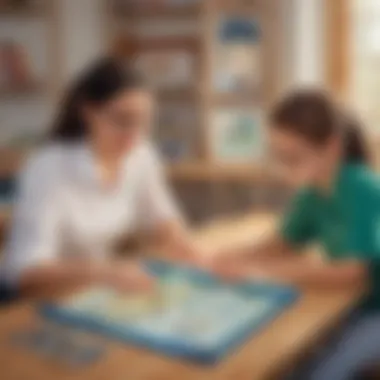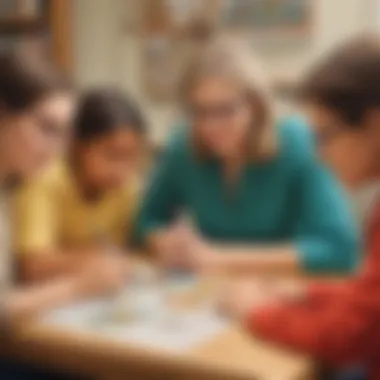Educational Kits for Students: Enhancing Learning


Intro
In the landscape of modern education, educational kits stand out as an invaluable tool for enriching students’ learning experiences. These kits are designed not merely to impart information but to ignite a passion for discovery among young learners. Whether it's through hands-on science experiments, thoughtful arts and crafts, or engaging problem-solving activities, educational kits offer various pathways for students to explore concepts that would otherwise remain abstract.
The approach of using kits aligns well with the hands-on learning philosophy, making education tangible and relatable. Parents, teachers, and caregivers hold a critical role in selecting the right educational kits, allowing children to engage with the material in meaningful ways. As we journey through this article, we will examine how educational kits can shape the minds of students, bridging the gap between theoretical knowledge and practical application.
Creative Activities
Craft Ideas
Creating with one’s hands can stir an incredible amount of joy and learning in children. Craft ideas, whether they involve painting, building, or simple DIY projects, captivate students' imaginations while teaching them about various subjects. For instance, making a model of the solar system can help reinforce lessons about space in a fun, constructive manner.
Examples of Craft Ideas:
- Paper Mache Planets: Using old newspapers and balloon molds, students can create colorful representations of planets. This hands-on activity allows them to learn about the physical characteristics of each planet in a tangible way.
- DIY Circuit Boards: With simple materials like LEDs and batteries, children can assemble basic circuit boards. Engaging with electronics not only sparks their interest but also provides an introduction to science and technology.
Step-by-Step Guides
Every craft idea can benefit from a detailed step-by-step guide. These guides lead students through the process, ensuring they understand each stage of their project:
- Gather Materials: Start by ensuring all necessary materials are handy—no one likes an unexpected trip to the store mid-project!
- Follow Instructions: Clearly written instructions help students grasp the sequence of steps. Consider including checkpoints where they can reflect on what they've learned or any challenges they faced.
- Showcase the Final Product: Encourage students to display their creations. This not only boosts their confidence but also allows for discussions about what they’ve learned.
Educational Value
Engaging in creative activities through educational kits isn’t just about making things. There are tangible educational benefits:
- Cognitive Development: Crafting fosters critical thinking and problem-solving skills.
- Fine Motor Skills: Cutting, assembling, and painting enhance coordination.
- Emotional Expression: Creativity offers children a medium to express their feelings and ideas in a constructive way.
Fun Quizzes
Quiz Topics
Quizzes are an excellent way for students to reinforce their knowledge and track their progress. Various quiz topics can be found in educational kits, covering subjects like:
- History: Key events and figures can become easier to recall through interactive quizzes.
- Science: Engaging with concepts such as gravity or ecosystems can be bolstered by targeted quiz questions.
- Math: Fun quizzes that challenge students’ understanding of arithmetic and geometry can help transition from basic concepts to more complex calculations.
Question Types
Diversity in question types makes quizzes more engaging. Here are a few common formats:
- Multiple-Choice Questions: Ideal for reinforcing factual knowledge.
- True/False Statements: These challenge students to think critically about what they’ve learned.
- Short Answer Questions: These require deeper understanding and articulation of concepts.
Knowledge Reinforcement
Quizzes serve an important role in knowledge reinforcement. They help solidify learning, making it easier for students to recall information in the future. Well-constructed quizzes also point out areas that may need further exploration or study. It’s a way for educators and parents to gauge comprehension without relying solely on traditional testing methods.
"Educational kits encourage children to learn actively, making education a joyous adventure rather than a chore."
Fact-Based Articles
Topics
In addition to interactive activities, educational kits often include fact-based articles. These articles cover an extensive range of subjects, such as:
- Environmental Science: Discussing ecological issues and conservation efforts.
- Cultural Studies: Learning about history and traditions from around the world.
- Technology: Understanding the basics of programming and robotics.
Engaging Content
The key to effective learning through articles lies in the method of presentation. Educational kits strive to make engaging content accessible and relatable:
- Clear Language: Using simple, straightforward vocabulary ensures comprehension among younger readers.
- Visual Aids: Incorporating images, diagrams, and infographics can bring concepts to life.
Prelude to Educational Kits
Educational kits have transformed the landscape of learning, offering innovative tools that serve as both educational resources and playful learning aids. In today's fast-paced world, where staying engaged can often feel like a challenging task, these kits present a refreshing solution to motivate students to explore new concepts actively. They cater to diverse learning styles, encouraging creativity while simultaneously ensuring that the educational experience remains relatable and enjoyable.
Definition and Purpose
An educational kit typically refers to a curated collection of materials, tools, and instructions that facilitate hands-on learning experiences. They can span a range of subjects including science, mathematics, language arts, and the arts. The purpose of these kits is multifaceted:
- Hands-on Experience: Engaging students with tangible materials can help reinforce theoretical knowledge. For instance, a science kit that enables children to conduct experiments fosters a deeper understanding than merely reading about theories in textbooks.
- Encouraging Curiosity: In a world where curiosity can sometimes be stifled by rigid teaching styles, educational kits spark interest. They often invite children to ask questions, explore solutions, and learn through discovery.
- Skill Development: Most educational kits are designed not only with academic knowledge in mind but also focus on essential life skills. These can include teamwork, problem-solving, and critical thinking, essential competencies in today’s society.
Historical Context
Historically, the concept of educational kits has evolved significantly. In the early 20th century, basic tools like simple board games were among the first attempts to combine play with learning. As education systems progressed and research revealed varied learning styles, the kits grew in complexity and application.


In the 1960s and 1970s, science and craft kits surged in popularity, inspired by the educational reforms touting experiential learning. In these decades, companies began producing kits that emphasized key scientific principles through experiments, experiments that kids can carry out at home or in the classroom. This marked a turning point, with the understanding that learning could, and perhaps should, be more engaging than traditional methods.
As we moved into the digital era, the emergence of technology-based educational kits incorporated electronics, robotics, and coding, making learning not only interactive but also relevant to the modern world. These advances kept pace with the needs of students and educators, creating a vibrant ecosystem for educational kits that are tailored to fit diverse educational goals.
Through this lens, educational kits are not merely products; they represent a significant shift in how knowledge is imparted, shaped by historical contexts and ongoing innovations in teaching strategies. Ultimately, they provide valuable insights into how we can enrich student learning experiences today.
Types of Educational Kits
In the world of education, not all tools are created equal. The type of educational kits one chooses can dramatically affect the student’s learning journey. When we talk about educational kits, we refer to curated collections of resources designed to enrich learning in various subjects. The importance of these kits lies in their ability to cater to different learning styles, igniting curiosity and enthusiasm in learners. It’s not just about providing facts but also about creating an interactive experience that solidifies knowledge through engagement. Here, we will explore different types of educational kits that serve distinct purposes and audiences, offering a wealth of advantages.
STEM Kits
STEM kits are a hot topic these days, often seen as the bread and butter for developing critical skills in science, technology, engineering, and mathematics. They encourage hands-on experimentation and problem-solving, making abstract concepts more tangible. For example, a chemistry kit allowing students to conduct safe, simple experiments can turn the classroom into a mini-laboratory.
By engaging with STEM kits, students not only learn foundational principles but also develop crucial skills like teamwork and analytical thinking. Here, experimentation does not merely turn theory into practice; it weaves a fabric of discovery that leads to deeper understanding. The takeaway? If educators seek to bolster interest in these essential fields, investing in robust STEM kits is a step in the right direction.
Arts and Crafts Kits
Creativity isn't just a nice-to-have; it’s essential for cognitive development. Arts and Crafts kits foster creative thinking and fine motor skills through hands-on projects. From painting to model building, these kits allow students to express themselves and explore their artistic capabilities.
Imagine a mixed media art kit where children sculpt with clay or experiment with colors on canvas. Not only does it promote self-expression, but it also introduces various artistic techniques and cultural contexts. Parents often overlook these kits, yet they play a pivotal role in helping children articulate thoughts that words sometimes fail to convey.
Language Learning Kits
Language learning kits open windows to new cultures and communication styles. By integrating games, flashcards, and audio materials, these kits offer immersive experiences designed for learners of all ages. They often cater specifically to vocabulary building, pronunciation practice, and comprehension skills—elements necessary for mastering a new language.
For instance, a Spanish language kit that incorporates storytelling and song not only builds vocabulary but also makes learning engaging. Kids who might shy away from traditional methods find themselves fascinated by the storytelling aspect, often leading to organic retention of new terms and phrases.
Social Studies Kits
Social Studies kits make history and geography lively and relatable. Instead of memorizing dates and events, students can engage with materials designed to illustrate the stories behind those facts. For example, a United States history kit might contain artifacts, role-playing activities, or interactive maps that bring historical figures and events to life. In doing so, kids gain a multi-dimensional understanding of their world.
Such kits help students understand the complexities of historical events and cultural differences. Instead of fostering a surface-level understanding, they delve into the sociopolitical dynamics and human experiences that shape society. They pave the way for a more informed and empathetic generation.
In essence, the choice of educational kits—be it STEM, arts, language, or social studies—makes a lasting impact on student engagement and learning outcomes. Each type serves its unique purpose, yet they all share a common goal: to inspire and facilitate deeper understanding that extends beyond textbooks.
Benefits of Educational Kits
The value of educational kits in today’s learning environment cannot be overstated. These kits serve not only as a tool for acquiring knowledge, but they also engage students on various levels. Researchers and educators have emphasized the need for interactive and applicable learning tools, especially in an era where traditional methods might not always resonate with younger minds. Let’s dig deeper into some key benefits these kits offer.
Enhancing Engagement
Students today are bombarded with information from multiple sources. Thus, capturing their attention is akin to trying to hold water in your hands. Educational kits, however, transform learning into an interactive experience. They provide hands-on activities that ignite curiosity. Instead of passively absorbing information, students actively participate.
For instance, a science kit featuring experiments on chemical reactions allows children to mix substances and observe outcomes. This not only makes learning enjoyable but also reinforces concepts through real-world applications. Workshops and classrooms have reported that students who use kits are more attentive and eager, quenching their thirst for knowledge through play.
Developing Critical Thinking
Educational kits are also a catalyst for honing critical thinking skills. These kits often pose challenges, requiring students to think outside the box. When faced with a problem, such as designing a simple engine using a STEM kit, children learn to assess situations, develop hypotheses, and test their ideas. This iterative process trains young minds to embrace challenges and learn from failure, which is vital in any learning journey.
Additionally, by encouraging experimentation and questioning, kits cultivate a mindset that values analysis over acceptance. It’s about teaching kids to ask “why” and “how,” rather than just memorizing facts.
Promoting Hands-On Learning
One of the distinguishing features of educational kits is their emphasis on hands-on learning. In an age where children often sit in front of screens, hands-on experience gives them the chance to apply concepts in tangible ways. Whether it's creating art with an arts and crafts kit or solving mathematical problems with manipulatives, the creativity unleashed through these kits is remarkable.
Learning by doing fosters deeper understanding and memory retention. It ties abstract ideas to real-world scenarios, making it easier for students to connect the dots. The result is a more enriching educational experience, where knowledge isn't just theoretical, it’s practical.
Fostering Collaboration
Lastly, educational kits are excellent for fostering collaboration among students. When working on projects in groups, children learn to communicate, share ideas, and tackle challenges as a unit. Such interactions build essential social skills and promote teamwork, which are crucial in both academic and personal growth.
Consider a situation where kids have a building kit. They must collaboratively decide how to build their structure, assigning roles and responsibilities. This shared experience builds camaraderie and encourages respect for different perspectives while also implementing skills like negotiation and compromise.
"Collaboration breeds innovation."
This seems especially true when students harness collective strengths for a common academic goal.
Educational Kits in Practice
Educational kits serve as invaluable instruments in fostering experiential learning, allowing students to engage meaningfully with academic material. They bridge theory and practice, transforming abstract concepts into tangible experiences. This section highlights how educational kits resonate in diverse learning environments, tailoring experiences for students, educators, and families.
Implementation in Classrooms
The classroom is a central stage for implementing educational kits. Here, hands-on kits facilitate a dynamic learning atmosphere. Students become more involved, engaging with materials instead of passively absorbing information. For example, a science kit that allows students to build a simple circuit not just teaches them about electricity— it inspires curiosity and experimentation.
Moreover, teachers can curate lesson plans that interweave these kits into their syllabus. This approach not only reinforces theoretical knowledge but also caters to various learning styles. Visual learners see, auditory learners discuss, and kinesthetic learners do. Overall, the implementation of educational kits enhances not just learning, but also retention and understanding, setting a solid foundation for future knowledge.


At-Home Learning Opportunities
Educational kits extend beyond the classroom, providing excellent at-home learning opportunities. For parents and caregivers, these kits can be a tool to enrich their child’s education. They foster an environment for learning beyond the confines of school hours. For instance, an arts and crafts kit can keep children busy while developing their creative skills. Children can master concepts like color theory or spatial awareness without even realizing it.
Additionally, families can engage together in activities from these kits. This involvement can strengthen family bonds while simultaneously enhancing children's learning. By participating, parents also gain insight into their child's interests and learning styles, which can inform how they approach education in the future. The options for home-based education are vast and customizable, fitting different family dynamics.
After-School Programs
After-school programs are another critical venue for utilizing educational kits. These settings offer opportunities for students to delve deeper into subjects they might be passionate about. For instance, a robotics kit in an after-school program can encourage teamwork and problem-solving skills while offering students a chance to express their creativity.
In these programs, kids can collaborate on projects, have a dash of competition, or simply explore and learn at their own pace. The use of educational kits ensures that learning continues beyond regular school hours, presenting challenges that keep young minds engaged. Furthermore, facilitators of these programs can adapt kits to align with children's varying levels of skill and comprehension, ensuring that every participant is supported in their learning journey.
"Using kits in after-school programs not only motivates children but also helps in social skill development—kids learn to communicate and work with others effectively."
In summary, educational kits play a multi-faceted role in enhancing the learning experience. Through their application in classrooms, at home, and in after-school programs, they provide countless avenues for students to explore, engage, and excel in their education.
Selecting the Right Educational Kit
Choosing the appropriate educational kit is crucial. It ensures that the learning experience is not only effective but also enjoyable. Educational kits come with various attributes that can cater to specific learning needs. By selecting the right kit, students can deepen their understanding in subjects that spark their interest and aid in their overall development.
Understanding Learning Goals
Before diving into the sea of options, it's vital to identify the learning goals associated with the kit. What are the aims? Are they about mastering a certain skill or acquiring knowledge in a particular area? Different kits target different objectives—some may focus on building problem-solving skills, while others emphasize creativity or analytical thinking.
For instance, if a student struggles with math, a kit designed to make math engaging through interactive elements might be suitable. On the other hand, if a student has an affinity for the arts, a craft kit that sparks creativity could be more beneficial. Keeping these goals in mind helps in selecting kits that resonate with students' learning journeys.
Age Appropriateness
Another factor to consider is the age appropriateness of the kit. Educational materials tailored for certain age groups offer experiences that match the developmental stages of learners. A kit that’s too advanced might discourage a child, while one that’s too simple can lead to boredom.
Take, for instance, science kits. A younger child's kit could focus on basic principles like density using simple liquid experiments, whereas a kit meant for older students might dive into complex concepts like chemical reactions. It's critical to align the kit's content with the age of the learners to keep them engaged and challenged appropriately.
Curriculum Alignment
Ensuring that the educational kits align with the curriculum is another key consideration. Parents and educators should check how the kit fits into the broader educational framework. Does it complement what students are learning in school? Is it designed to meet certain educational standards?
For example, a language learning kit that incorporates vocabulary and grammar aligned with what students are currently studying in their classrooms will reinforce their daily lessons. You can often find kits labeled with curriculum standards, making it easier to see how they can be integrated into regular teaching.
"Choosing the right educational kit is like laying a solid foundation for a house—everything built on it relies on its strength."
In summary, selecting the right educational kit requires a thoughtful approach. By considering learning goals, age appropriateness, and curriculum alignment, parents and educators can make informed choices that enhance the educational experience for students. Engaging with the right kits can spark curiosity and develop a passion for learning that lasts a lifetime.
Integrating Technology with Educational Kits
In this digital age, the integration of technology with educational kits is becoming increasingly important. This convergence opens up new avenues for learning, making education not just a routine but an engaging exploration. By marrying traditional educational kits with technology, educators can create a rich tapestry of learning experiences that cater to the diverse needs of students. The relevance of this topic goes beyond mere functionality; it’s about enhancing interactive capabilities and fostering collaboration on a whole new level.
Online Resources and Tools
Online resources and tools play a crucial role in supplementing educational kits. They add layers of depth to the learning process, offering students access to a world of knowledge right at their fingertips. For instance, there are countless educational websites and applications that complement hands-on kits, delivering virtual simulations or additional informational content.
A few noteworthy examples include:
- Khan Academy: Provides video tutorials and exercises on a variety of subjects, which can support the concepts found within STEM kits.
- Edmodo: Acts as a platform where teachers and students can collaborate, share resources, and discuss projects related to their learning kits.
These resources encourage students to take charge of their learning and allow parents and educators to track progress. This access to curated information helps solidify the learning objectives outlined in the kits, encouraging curiosity and inquiry.
Interactive Learning Platforms
Interactive learning platforms add another layer of excitement and engagement. These platforms are designed to make learning feel more like play, which can be particularly appealing for elementary students. They leverage gamification and interactive elements to keep kids interested and involved in the subject matter.
Some popular interactive platforms include:
- Kahoot!: This allows educators to create quizzes linked to the themes of their educational kits, encouraging friendly competition and interactive learning.
- Quizlet: Students can create flashcards or interactive games based on the topics they are studying, which can be paired seamlessly with the concepts outlined in language or social studies kits.
Moreover, many of these platforms offer adaptability to different learning styles, catering to visual, auditory, and kinesthetic learners alike. They facilitate a blend of independent and collaborative learning, enabling students to work on projects collectively, even from afar.
"Integrating technology into educational kits not just enhances the learning experience, it transforms it into a shared adventure, encouraging creativity and connectivity."
Challenges in Using Educational Kits
When we talk about educational kits, it's easy to get lost in their benefits. However, it's equally important to cast a light on the challenges that come with their usage. Understanding these obstacles can empower parents, teachers, and students to tackle them head-on, ensuring that the experience with these kits is beneficial instead of burdensome. Challenges can range from cost implications to the accessibility of necessary resources, all of which can affect the potential success of educational kits in a learning environment.
Cost Considerations
One of the most pressing issues when it comes to educational kits is the price tag. Kits can vary widely in cost, from affordable options to those that demand a significant investment. Many parents or even schools are on a tight budget, which means they have to think twice before purchasing kits that may or may not deliver the promised educational outcomes.


- Budget Constraints: Schools, particularly public ones, often struggle with funding that restricts what they can invest in educational tools. This limitation can lead to a narrow selection of all available kits.
- Long-Term Investment: While some might see a higher price as a downside, it’s essential to consider the long-term benefits. A well-constructed kit that integrates multiple learning opportunities can pay off when students retain knowledge longer.
- Hidden Costs: Sometimes the initial price doesn't reflect ongoing costs. For instance, certain kits might need extra supplies that can add up over time. Being aware of these hidden costs is crucial.
Thus, it's vital for parents and educators to evaluate kits not just based on upfront prices but on the educational value they deliver over time.
Resource Availability
Another challenge that plagues educational kits is the availability of resources. Even the most brilliant kit won’t succeed if the necessary materials are hard to come by or not readily accessible.
- Community Variability: In diverse communities, resources can differ vastly. A kit that’s great in one location might not be feasible in another due to thiếu of available materials or tools.
- Supply Chain Issues: Many kits rely on specific materials that may not always be in stock. Unexpected shortages can lead to frustration, particularly for teachers and parents aiming to facilitate learning.
- Training Needs: Some kits may require special skills or training for effective use. This can pose another barrier for educators who want to integrate these kits into their curriculum but feel unprepared or lack support.
"Being informed about potential cost and resource issues can help in making more informed decisions regarding educational kits."
Balancing the benefits against these hurdles enables families and educators to make the most out of educational kits.
Case Studies of Successful Implementation
Examining how educational kits are used effectively in real-world settings gives valuable insight into their potential impact. These case studies show not just the functionality but also the transformative possibilities kits can bring to different learning environments. They serve as proof points that can guide educators and parents in their decision-making process, emphasizing the practical benefits and considerations associated with adopting these versatile tools in various educational contexts.
School Programs Utilizing Kits
In recent years, numerous schools have integrated educational kits into their curricula, revealing remarkable outcomes. For example, the STEM Explorers program at Lincoln Elementary School utilized engineering kits from LEGO Education. The students engaged in building simple machines, which sparked an interest in physics and mechanics. Not only did they learn core concepts, but they also developed problem-solving skills that they could apply beyond the classroom.
Benefits Observed:
- Enhanced Engagement: Students who typically found science less appealing showed increased enthusiasm. Kits injected excitement into the learning process.
- Improved Collaboration: Working in groups encouraged teamwork and communication, which are essential skills in any learning environment.
- Real-World Application: Hands-on activities helped students relate theoretical concepts to practical situations, aiding retention and understanding.
Another example can be seen in the Art for All initiative at Oakridge Middle School. Here, art kits were used to teach students about various artists and styles while allowing them to express their creativity. Teachers reported that students were not only learning art techniques but were also exploring their personal identities through art. This program not only boosted creativity but also contributed to emotional well-being.
Parental Reports and Testimonials
The feedback from parents is often a window into the success of educational kits, highlighting their effectiveness from a home perspective. One mother described how her child used a language learning kit from Rosetta Stone Kids. At first, she was skeptical, doubting how much her child could absorb. However, after a few weeks, her son was not just participating but actively engaging with the materials.
"I was amazed at how quickly he picked up new words! It’s like the kit opened a door to learning he didn’t even know was there."
This sentiment reflects a broader trend where parents note improved learning outcomes, enhanced interest in various subjects, and often more significant changes in behavior towards education altogether. Parents of students in the Nature Explorers program have similarly noted that their children showed increased curiosity about the environment. They credited the hands-on activities with promoting mindfulness and responsibility.
Parents appreciate the range of kits available for different subjects and age levels. Many emphasize the importance of selecting kits that align not just with school curricula but also with their children's personal interests. This personalized approach can make all the difference in maintaining motivation and fostering a love for learning.
Culmination of Insights
The implementation of educational kits in schools shows promising results, impacting both student engagement and learning outcomes. Through real-life examples, we see how these kits serve as catalysts for deeper understanding and excitement about the content. Furthermore, the narratives from parents attest to the kits' positive ripple effects in homes. Both these perspectives underscore the growing importance of educational kits as essential instructional tools in contemporary education.
Future Trends in Educational Kits
As we look ahead, the landscape of educational kits is undergoing a transformation that intertwines with the latest advancements in technology and educational philosophy. Understanding these future trends can provide crucial insights for parents, educators, and stakeholders invested in the development of effective learning tools for children.
Emerging Educational Technologies
In recent years, the intersection of technology and education has taken center stage. Emerging educational technologies are set to redefine how kits function. These innovations can significantly enhance engagement and facilitate interactive learning. For instance, kits that incorporate elements of augmented reality (AR) or virtual reality (VR) provide immersive experiences that traditional methods simply cannot match. Imagine a science kit where learners can explore the human body from the inside out, interacting with 3D models as they understand anatomy or systems biology. These types of engaging experiences can not only make learning enjoyable but also deepen comprehension and retention.
Moreover, the integration of artificial intelligence in educational kits allows for personalized learning experiences tailored to each child's unique needs. As kits become smarter, they can adapt to the pace and style of learning of the user, whether they are visual, auditory, or kinesthetic learners. This tailored approach helps keep students motivated and focused, ensuring that they are neither overwhelmed nor under-challenged by the material.
In addition, gamification is an emerging trend where educational content is presented through game-like formats. This can shift the motivation from merely completing tasks to engaging fully with the content, encouraging critical thinking and problem-solving in an enjoyable way that resonates with children.
Sustainability in Educational Materials
Another crucial trend is the push towards sustainability. As awareness around environmental issues grows, so does the demand for eco-friendly educational kits. Parents and educators are becoming increasingly conscious of the materials that make up these kits. They prefer options crafted from biodegradable or recycled materials, ensuring that the learning tools not only enrich students' minds but also protect the planet.
Educational producers are stepping up to meet this expectation by using sustainable manufacturing practices and ethical sourcing. For example, a growing number of art and craft kits now feature supplies that are non-toxic and derived from sustainable resources. Furthermore, kits that encourage upcycling—using everyday materials to create or learn something new—are gaining traction. Such initiatives can impart valuable lessons about waste reduction while teaching children creativity and resourcefulness.
"Sustainability in education is not just about using ‘green’ materials. It is about teaching children to be stewards of their environment while they learn."
In summary, the future of educational kits lies in the marriage of innovative technology and sustainable practices. This evolution speaks not just to better educational outcomes but to a responsibility towards our planet and future generations. Ensuring these kits are accessible and effective will require thoughtful considerations from all stakeholders involved.
The End
In wrapping up the discussion on educational kits, it becomes clear that these tools are more than mere pastime activities; they encapsulate a vital aspect of modern education. As we sift through the layers of benefits they offer, it’s evident that educational kits can transform mundane learning into an engaging and hands-on experience. From the variety of subjects covered to the fostering of creativity, the advantages are numerous and multifaceted, making a case for their widespread adoption.
Summarizing Key Insights
To distill the essence of our exploration:
- Engagement: Educational kits transform conventional lessons into vibrant activities, capturing students' interest and making learning enjoyable.
- Critical Thinking: Utilizing these kits encourages students to ask questions, solve problems, and think critically about the subjects they are studying.
- Hands-On Experience: The tactile nature of many kits allows learners to delve deep into practical applications, reinforcing their knowledge through direct interaction.
- Collaboration: They often promote group work, fostering a spirit of teamwork that is essential in today's interconnected world.
Each of these insights paints a picture of just how crucial educational kits are becoming in the toolkit of educators and parents alike.
Implications for Stakeholders
For parents, educators, and policy-makers, understanding the implications of integrating educational kits into learning environments is imperative. Here are some points to consider:
- Resource Allocation: If schools and homes alike invest in educational kits, they must plan budgets accordingly, ensuring that what's spent yields beneficial outcomes.
- Curriculum Development: Integrating these kits into lesson plans requires thoughtful consideration, aligning the kits with educational objectives and standards.
- Parent Involvement: Caregivers can take an active role in their child's learning by participating in activities utilizing these kits, reinforcing knowledge and building connections.
Ultimately, the onus is on stakeholders to create an enriching and supportive environment that takes advantage of the potential these educational kits hold. With thoughtful implementation, the future of education can be both enlightening and impactful.







